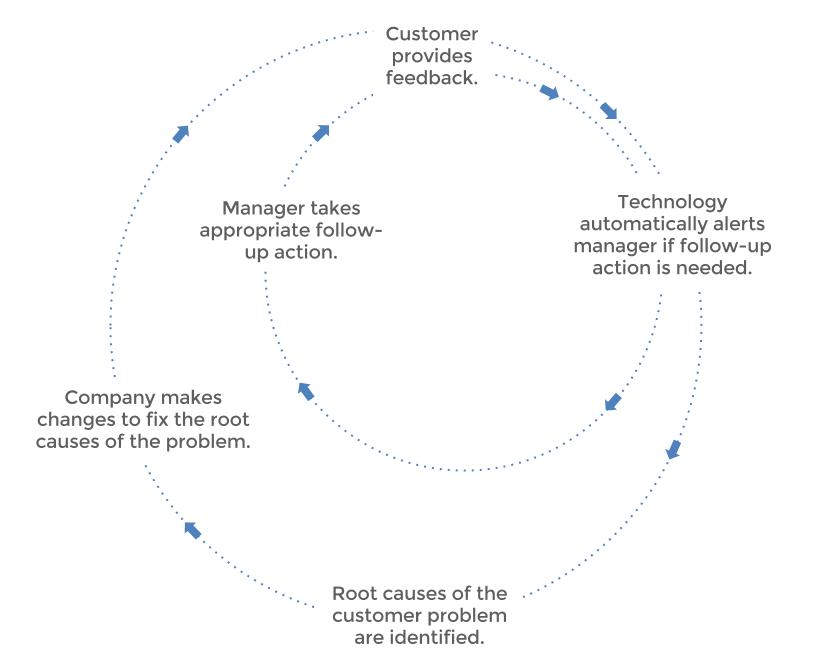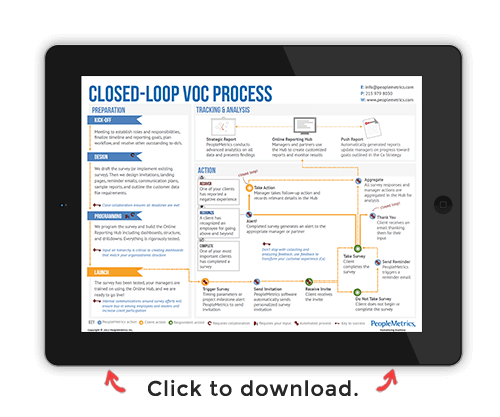If you’ve been keeping up with this series, you're familiar with the idea of gathering continuous customer feedback. But it's important to note the changing environment for how that feedback is handled.
Traditionally, customer satisfaction surveys have focused on collecting aggregate data. In the world of market research, this approach makes sense. It’s statistically accurate, high-level, and shows trending data—all great things for market researchers. But as customers have become more aware and their expectations have risen, this “open-loop” system falls short. Customers expect that if they take the time to provide personal feedback, then someone should take the time to provide personal follow-up.
A closed-loop customer feedback management system gives institutions the tools they need to take this personal follow-up and “close the loop” on each piece of customer feedback. Ideally, your system should work on two different but complementary levels:
- Support follow-up with individual customers based upon their feedback (as depicted by the smaller circle in the diagram below), and
- Deliver insights from aggregate feedback to drive action that will benefit all or a sub-set of the bank’s customers (as depicted by the larger circle):

Five Requirements for Effective Follow-up with Individual Customers
These qualities should be present in any effective customer feedback management solution as it relates to following up with individual customers:
1. Non-Anonymous
Patricia Smith, President of Wealth Management at First Interstate Bank, explains the difference between our ongoing Voice of the Customer program and prior efforts the bank had undertaken to listen to customers:
"The biggest component in our relationship with PeopleMetrics is that the surveys aren’t anonymous, and it is a continuous improvement process—meaning we are able to attach the responses, then look at the customer relationships and better understand what’s working well and where our areas of opportunity lie.”
When you're trying to close the loop, you do not have to protect the identity of your customers who give you feedback. Two-way communication and dialogue is fundamental to a solid and healthy relationship with them.

2. Action Triggers Built into Survey Design
Don't fall into the trap of asking your customers about all the elements of the experience that only matter to the bank’s leadership, managers and employees. Did our staff greet you by name? Did you have to wait in line longer than 2 minutes? Were you able to easily find our mobile banking app?
If you impose such questions, but they aren’t tied to issues or important to your customers, you can do little with the insights. Instead, structure an extremely short survey that elicits what’s important to the customer, what happened to them that warrants sharing, provides room to elaborate in their own words, and points bank employees to what they should do next.
The survey questions used in a closed-loop feedback program should clearly point to the best next action the bank should take.
3. Automated Notifications
It is possible now to trigger automatic notifications (e.g., email, SMS) to bank representatives that alert the employee to a piece of customer feedback requiring action.

These automatic notifications are a core element in a closed-loop customer feedback system. It helps branch managers hear from customers, quickly determine the context of feedback, and respond accordingly.
Common automatic notifications or Action Alerts include:
- Recover Notifications or Course Correct Alerts, when an unresolved problem is dissatisfying the customer;
- Improve or Innovate Alerts, when a customer has a suggestion for how the bank or the channel can get better; and
- Recognize or High Five Alerts, when an employee has gone above and beyond and is deserving of recognition.
Many of our banking clients are also adopting Grow or Opportunity Alerts, which help employees identify opportunities for cross-selling and up-selling to their clients. This soft lead generation tool is helping to shift the culture at one of our client’s banks from one that is purely about service to one where sales, in the name of helping the customer, is an essential and acceptable part of the experience.
4. Case Management Tools
Asking managers to take action on real-time customer feedback requires work on their end. Strong closed-loop feedback programs provide tools to help managers delegate follow-up actions and track the progress of open cases. Case management tools make it easy to create transparency around the customer experience and ensure that no piece of feedback gets lost or overlooked.

5. Root Cause Tracking
As your managers or other employees close the loop with customers, they should document the root cause of the issue within the case management system. Perhaps customers are complaining about a lack of knowledge of staff at a given branch, and you know that branch has had high turnover and many new hires in recent months. Or perhaps numerous comments related to unexpected branch closings reveal a poor communications plan. By tracking root causes, you will be able to identify areas to improve your operations and eliminate the issues moving forward.
Takeaways
A closed-loop customer feedback program is a must-have for any bank looking to grow in this age of the customer. Learn more about the steps to follow by downloading our free closed-loop Voice of the Customer process map by clicking on the image below.





%20(1).png)